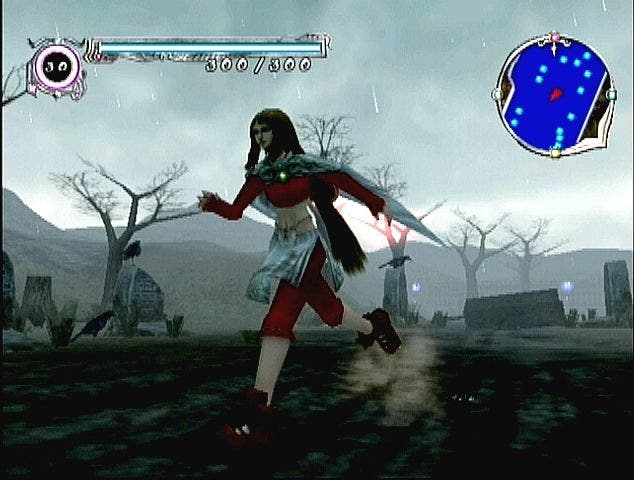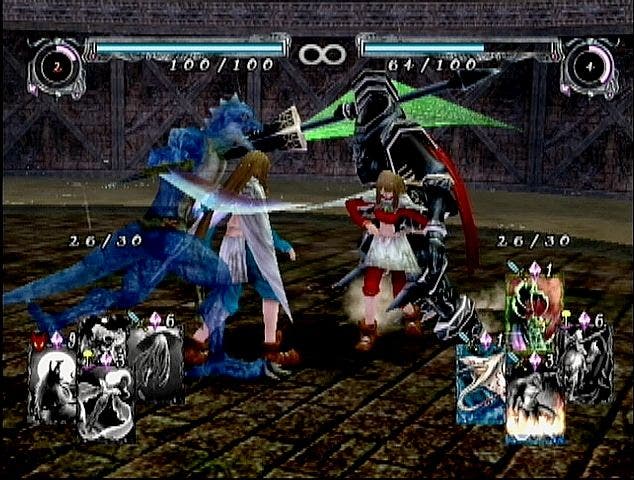Lost Kingdoms
Review - card-carrying Princess Katia is a girl of little substance, sadly

So close…
For a while, I thought this was going to be dead good. Playing Lost Kingdoms for a couple of hours on the evening I received it, I fell in love with the subtle complexity of the card-battling system, and this brief love affair continued for a fortnight or so. However, before long things started to fall apart for this cute little card-carrier, and in the end I was quite pleased to see the back of Princess Katia and the threat of the black mist.
Why? In short, a lack of depth was to blame. The story behind Lost Kingdoms is weak, starring the aforementioned Red Riding Hood look-a-like of noble descent on a quest to find her father and defeat the black mist, which has smothered the various kingdoms of the world and destroyed the lives and livelihoods of their occupants. In order to do this, Katia must first master the art of the magic cards. She receives her first shock in her very own castle, having to take down a couple of skeletons with a single magic card, before venturing out into the world and learning from a seasoned old hag.
The biggest change to the traditional RPG formula is From Software's decision to limit character development in favour of building up decks of cards. You travel across a map screen taking on various levels with up to 30 cards of your choosing in a prearranged deck, and you have to clear ruins, fields and towns by wielding them in random battles. Apart from a couple of regular stop-offs to deposit rescued magical sprite things and to visit the old crone who tutored her, Katia takes on each level repeatedly until she gets through to the other side without dying or running out of cards.

Card-again!
When Katia encounters an enemy (or multiple adversaries) the game switches to a battle view, trapping you in a small area with your enemies and an irritating battle theme which becomes almost intolerable after a couple of hours. You then dash about using the analogue stick to evade their attacks, and the face buttons to use your cards. The game shuffles the top four cards as you chose them before the level began and places them onto the face buttons, the idea being to hit buttons to wield the corresponding cards.
The strategy is in choosing the right card for the right enemy. The game splits things up into four elements: fire, water, wood and earth, with a separate neutral category, and the idea is to choose the opposing element to the enemy's to achieve maximum effect. Before long your deck consists of most of the enemies you have defeated, and it becomes simpler to work out which card to use in the heat of battle, but you also have to consider what the card actually does. Some conjure up monsters to fight on your behalf, whilst others transform you completely. Others still work as melee attacks, swiping ethereally from within Katia or swooping down from behind her and ploughing into whatever lies directly ahead.
When struck, enemies drop jewels, which in turn power the cards further. After a while though, cards run out and you move onto the next in the pack. What's frustrating about this is that often jewels are hurled away and obscured by the scenery, or are simply too hard to pick out against a particular piece of shiny stone, and by not grabbing them you limit your chances of being able to stay on the offensive. Luckily, if you do take a hit you can employ some healing spells, which is why it pays to design your decks after you've worked out how effective you are in battle, but ultimately luck plays just as important a part as strategy.

Rapid Decline
The trouble with Lost Kingdoms is that beyond the strategy of building a deck to match the conditions and opposing elements there isn't a lot to do. The card system has been included almost entirely at the expense of character development, and the story is pretty clichéd and tedious fantasy tripe - nowhere near as twisted and adventurous as those witnessed in the Final Fantasy games and elsewhere.
Level design also falls on the wrong side of the fence, with too many winding, skeletal ruined houses hiding secret cards in chests, and having to race around these little mazes because Katia is apparently incapable of stepping over a two foot wall proves a little much. What's worse is that the random battle system means that you just slope around looking for the way out and hoping to escape conflict, and almost every encounter is met with a groan. Puzzles which unlock doors are simple, often requiring Katia to wander over to a pump and drain a fountain to fetch a key, or something equally preposterous, and in some cases the developer has resorted to simple substitution conundrums.
One of my least favourite sections was a puzzle prior to a boss fight, which had me touching the graves of four former kings in an effort to guess the right order and unlock a gate. Failure at any given step was met with a horde of skeletons to defeat. Unpleasant. Getting killed in the subsequent boss fight and having to replay the entire level didn't do much for my temper either. Mid-level shuffling points go some way to redressing the balance, and once you've learnt to retreat to these now and then things become a deal easier, but you will find yourself repeating levels more often than not after a few hours.

King in the Tail
Continuing the trend of missed opportunities we have the graphics engine. Lost Kingdoms doesn't look bad, per se, but it could have been a lot better. Katia herself is poorly detailed, spinning around like a top and running like a weary gazelle, and NPCs are as soulless as the undead she conquers. Although some of the enemies are fun to see in action, and as a result some of her summonings and battle effects, they too become repetitive, lacking variation in behaviour and animation. The sound effects are so-so, and there's no voice acting to speak of - the whole story is told via text. Presentation is acceptable enough, but when some battles drag the framerate down and you aren't even all that pleased with the spectacle to begin with, you don't really appreciate the finer details.
The final nail in Katia's coffin is the camera system. It's too static by far, with only four positions which always seem to leave you working at a diagonal. The sad thing is that the camera smoothly sweeps between these, suggesting that a free camera wouldn't have been too much extra effort to implement. Ah well, perhaps things will improve in the recently announced sequel.
I was prepared to give Lost Kingdoms a proper slating for a while, but it did have one final surprise left in store for me. The two-player arena mode, which has you facing off against another player using pre-chosen decks, can be a lot more entertaining than your average beat 'em up, and the main adventure often plays second fiddle, because the multiplayer aspect can last you for hours at a time. Sadly though, it probably isn't enough to rescue Lost Kingdoms. After 15 hours I wasn't too sad to see the back of the single player game, and with games like Smash Bros available on the Cube there wasn't much incentive to drag my usual Friday night gaming party back to this.
Conclusion
Lost Kingdoms could have been a big success, and it's obvious that Activision anticipated this in snatching it up and releasing it as the Cube's first RPG, but From's Cube debut is a bit short on substance, even if it does employ the best card-battling system I've seen in a videogame. If you can stomach the repetition and reckon the card-battling and multiplayer elements sound like your kind of thing, then it might be worth picking your way through this until the big Cube releases turn up later this year, but otherwise, I would give this a miss and see what From does with the sequel.

